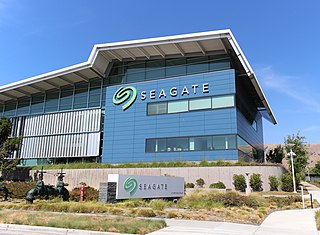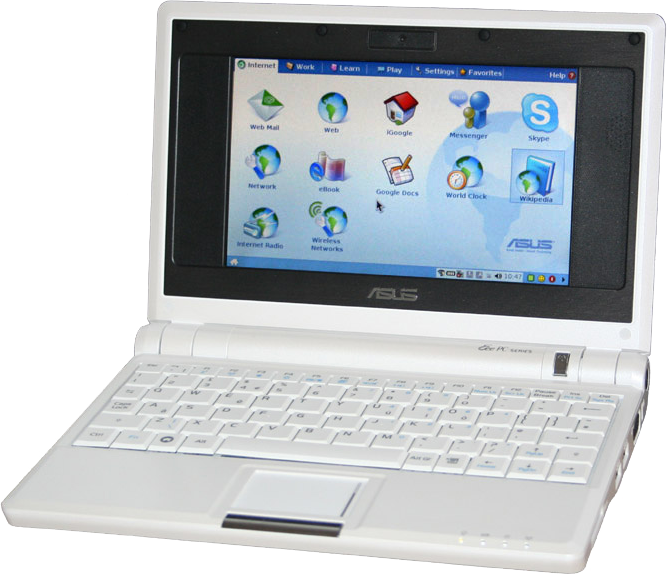Related Research Articles

A hard disk drive (HDD), hard disk, hard drive, or fixed disk is an electro-mechanical data storage device that stores and retrieves digital data using magnetic storage and one or more rigid rapidly rotating platters coated with magnetic material. The platters are paired with magnetic heads, usually arranged on a moving actuator arm, which read and write data to the platter surfaces. Data is accessed in a random-access manner, meaning that individual blocks of data can be stored and retrieved in any order. HDDs are a type of non-volatile storage, retaining stored data even when powered off. Modern HDDs are typically in the form of a small rectangular box.

Flash memory is an electronic non-volatile computer memory storage medium that can be electrically erased and reprogrammed. The two main types of flash memory, NOR flash and NAND flash, are named for the NOR and NAND logic gates. Both use the same cell design, consisting of floating gate MOSFETs. They differ at the circuit level depending on whether the state of the bit line or word lines is pulled high or low: in NAND flash, the relationship between the bit line and the word lines resembles a NAND gate; in NOR flash, it resembles a NOR gate.

Western Digital Corporation is an American computer hard disk drive manufacturer and data storage company, headquartered in San Jose, California. It designs, manufactures and sells data technology products, including storage devices, data center systems and cloud storage services.

Seagate Technology Holdings plc is an American data storage company. It was incorporated in 1978 as Shugart Technology and commenced business in 1979. Since 2010, the company has been incorporated in Dublin, Ireland, with operational headquarters in Fremont, California, United States.

A USB flash drive is a data storage device that includes flash memory with an integrated USB interface. It is typically removable, rewritable and much smaller than an optical disc. Most weigh less than 30 g (1 oz). Since first appearing on the market in late 2000, as with virtually all other computer memory devices, storage capacities have risen while prices have dropped. As of March 2016, flash drives with anywhere from 8 to 256 gigabytes (GB) were frequently sold, while 512 GB and 1 terabyte (TB) units were less frequent. As of 2018, 2 TB flash drives were the largest available in terms of storage capacity. Some allow up to 100,000 write/erase cycles, depending on the exact type of memory chip used, and are thought to physically last between 10 and 100 years under normal circumstances.

Micron Technology, Inc. is an American producer of computer memory and computer data storage including dynamic random-access memory, flash memory, and USB flash drives. It is headquartered in Boise, Idaho. Its consumer products are marketed under the brands Crucial and Ballistix. Micron and Intel together created IM Flash Technologies, which produces NAND flash memory. It owned Lexar between 2006 and 2017.

A disk enclosure is a specialized casing designed to hold and power disk drives while providing a mechanism to allow them to communicate to one or more separate computers.

Lexar Media, Inc. is an American brand of flash memory products manufactured by the Chinese company Longsys.
Kingston Technology Corporation is an American multinational computer technology corporation that develops, manufactures, sells and supports flash memory products and other computer-related memory products, as well as the HyperX gaming division. Headquartered in Fountain Valley, California, United States, Kingston Technology employs more than 3,000 employees worldwide as of Q1 2016. The company has manufacturing and logistics facilities in the United States, United Kingdom, Ireland, Taiwan, and China.

A solid-state drive (SSD) is a solid-state storage device that uses integrated circuit assemblies to store data persistently, typically using flash memory, and functioning as secondary storage in the hierarchy of computer storage. It is also sometimes called a semiconductor storage device, a solid-state device or a solid-state disk, even though SSDs lack the physical spinning disks and movable read–write heads used in hard disk drives (HDDs) and floppy disks.
sTec is an American computer data storage technology company headquartered in California, with research and development, sales, support or manufacturing sites in China, India, Japan, Malaysia, Silicon Valley (USA), and Taiwan.

The ASUS Eee PC is a netbook computer line from Asus, and a part of the ASUS Eee product family. At the time of its introduction in late 2007, it was noted for its combination of a lightweight, Linux-based operating system, solid-state drive (SSD), and relatively low cost. Newer models added the options of Microsoft Windows operating system and rotating media hard disk drives (HDD), and initially retailed for up to 500 euros.

In electronics, a multi-level cell (MLC) is a memory cell capable of storing more than a single bit of information, compared to a single-level cell (SLC), which can store only one bit per memory cell. A memory cell typically consists of a single floating-gate MOSFET, thus multi-level cells reduce the number of MOSFETs required to store the same amount of data as single-level cells.

SanDisk Professional is a brand of Western Digital that produces external storage products designed and marketed for the Macintosh, creative pro, photography and A/V markets. Its USB, FireWire, eSATA, SAS, SCSI Thunderbolt, and Fibre Channel systems support all levels of audio/video production.
A trim command allows an operating system to inform a solid-state drive (SSD) which blocks of data are no longer considered to be 'in use' and therefore can be erased internally.
NVM Express (NVMe) or Non-Volatile Memory Host Controller Interface Specification (NVMHCIS) is an open, logical-device interface specification for accessing a computer's non-volatile storage media usually attached via PCI Express (PCIe) bus. The acronym NVM stands for non-volatile memory, which is often NAND flash memory that comes in several physical form factors, including solid-state drives (SSDs), PCI Express (PCIe) add-in cards, and M.2 cards, the successor to mSATA cards. NVM Express, as a logical-device interface, has been designed to capitalize on the low latency and internal parallelism of solid-state storage devices.

IBM FlashSystem is an IBM Storage enterprise systems that store data on flash memory. Unlike storage systems that use standard solid-state drives, IBM FlashSystem products incorporate custom hardware based on technology from the 2012 IBM acquisition of Texas Memory Systems.

3D XPoint is a non-volatile memory (NVM) technology developed jointly by Intel and Micron Technology. It was announced in July 2015 and is available on the open market under the brand name Optane (Intel) since April 2017. Bit storage is based on a change of bulk resistance, in conjunction with a stackable cross-grid data access array. Initial prices are less than dynamic random-access memory (DRAM) but more than flash memory.
In-situ processing also known as in-storage processing (ISP) is a computer science term that refers to processing data where it resides. In-situ means "situated in the original, natural, or existing place or position." An in-situ process processes data where it is stored such as in solid-state drives (SSDs) or memory devices like NVDIMM, rather than sending the data to a computer's central processing unit (CPU).
References
- ↑ Bernath, Tyler (November 12, 2019). "Crucial X8 1TB Portable SSD Review". TweakTown. Retrieved March 7, 2020.
- ↑ Tallis, Billy (October 24, 2019). "Crucial Introduces X8 Portable SSD". AnandTech. Retrieved March 7, 2020.
- ↑ Scher, Rod (January 31, 2020). "Crucial X8 Review". PC Magazine. Retrieved March 7, 2020.
- ↑ Webster, Sean (January 13, 2020). "Crucial X8 Portable SSD Review: a Speedy Value". Tom's Hardware. Retrieved March 7, 2020.